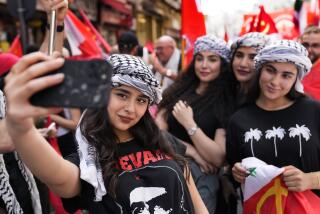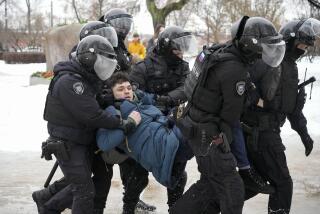Russians Put More Spring Into Their May Day : Holiday: It’s no longer a regimented, proletarian affair. Some Bolshevik die-hards march in Moscow, but most just take a pleasant day off.
- Share via
MOSCOW — From the red-bannered proletariat festival of past decades, May Day turned this year into simply a pleasant occasion for all Russia to breathe in the newly warm, scented air and sigh, “Ah! Spring!”
In a reflection of Russia’s struggle to invent an appealing new culture for itself now that the old ideology is dead, the Soviet red-letter day that, under Communist Party rule, celebrated “international worker solidarity” took on a blurry new definition Friday.
It is henceforth to be known as “the Holiday of Spring and Labor.”
“I used to march in May Day demonstrations when I was a student,” kindergarten teacher Raisa Proshina said. “Now, May Day has become just a nice spring day off, nothing more than that.”
On Red Square, where giant holiday portraits of Communist idols Karl Marx, Friedrich Engels and V.I. Lenin used to hang and party leaders once lined the Lenin Mausoleum, neutral pictures of spring flowers and butterflies rose from the cobblestones. No one stood on the mausoleum.
In one choice spot in the center of the square stood an advertisement for vacations in the Canary Islands, touting their “323 sunny days a year.” On the History Museum at one end of the square hung a giant slogan, paid for by an international fund supporting free speech, proclaiming, “Freedom Works!”
The whole mood of the holiday, under hazy blue skies, did carry a new sense of freedom, a do-your-own-thing attitude that contrasted powerfully with the regimentation of the old days when workers were forced by their supervisors to march through the square in neat rows carrying mass-produced banners.
For the first time, stands selling food and drink were set up on the normally sacrosanct territory of Red Square, and the old no-smoking rule was not enforced.
“Each social movement, city or individual is free to celebrate the holiday in their own way,” commented Itar-Tass, the official news agency.
The anti-Communist administration of Moscow even gave a free hand to an estimated 25,000 die-hard Bolsheviks who, intent on retaining May Day’s old atmosphere, marched around Moscow and across Red Square wielding hundreds of red flags and signs in a straggling imitation of the old “workers’ demonstrations.”
For two hours beginning at noon, the pro-Communist activists rallied in Red Square, their voices echoing from loudspeakers placed on the Kremlin’s walls as they called for the restoration of the Soviet Union and the resignation of President Boris N. Yeltsin’s government.
“Did the people give Yeltsin a mandate to dismember the Soviet Union?” Russian legislator Yuri Slobodkin demanded. “Did the people give him a mandate to restore capitalism? Did they give him a mandate to dismantle the councils of deputies? Did they give him a mandate to let Washington and the International Monetary Fund decide our domestic and foreign policy?
“We say, ‘No, no and no!’ ” Slobodkin declared.
Typically for such pro-Communist meetings, many of the slogans printed on signs and shouted by the crowd were anti-American and anti-Semitic. One woman yelled as she marched, “Send Yeltsin to Israel! Send Yeltsin to Israel!” and a prominent sign depicted Yeltsin and former Soviet President Mikhail S. Gorbachev framed by a Star of David under the title, “The Zionist Twins.”
But when their two hours were up, the Communists quietly left the square, causing no squabbles with the hundreds of police officers lining it, and troupes of singers and performers moved in to continue the day’s festivities, which after dark included open-air discotheques.
Along with its new gaiety, this year’s May Day appeared to mark a newly apolitical phase in Russian culture.
Reports from across the vast country indicated that the majority of people who, even last year, would have been marching or protesting on one side or the other, decided to spend the day in the countryside working on their gardens or relaxing.
In the Siberian city of Ulan Ude, fewer than 400 people turned out for the May Day march out of a total population of 380,000, and in the major industrial center of Chelyabinsk, only 300 showed up, Itar-Tass reported.
Along with Revolution Day on Nov. 7, May Day used to be one of the two top Communist holidays in the Soviet Union, and the ritual gathering of top leaders on the mausoleum to watch the masses march by used to provide Kremlinologists with crucial fodder on jockeying for position within the Politburo.
But soon after Gorbachev came to power in 1985, May Day began to change from a tightly controlled political exercise into a forum for real protests. And in 1990, marchers shocked onlookers by jeering Gorbachev so insistently as he stood atop the mausoleum that he walked off in a huff after about 20 minutes.
By last year, it was already clear that the whole holiday had lost its oomph. The Moscow City Council told residents they could put their time to better use spring-cleaning than marching, and the measly 7,000 demonstrators who crossed Red Square had a spiritless air.
Now, with the Communist Party banned in the wake of last August’s coup attempt and the Soviet Union dissolved, May Day appears changed for good, and aside from the Communist protesters, few people seem to be complaining.
Eventually, said history student Sergei Pochkin as he watched the remaining Communists assemble their ranks, “I believe this holiday, like many others, will disappear naturally.”
Andrei Ostroukh, a reporter in The Times’ Moscow bureau, contributed to this story.
More to Read
Sign up for Essential California
The most important California stories and recommendations in your inbox every morning.
You may occasionally receive promotional content from the Los Angeles Times.










